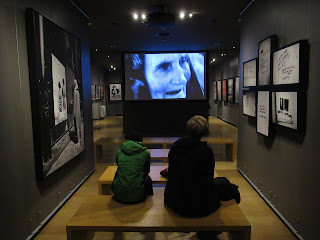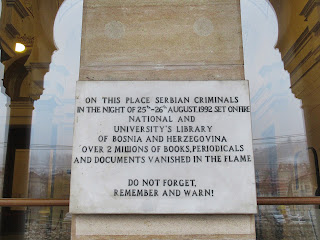



Driving into Bosnia was a sobering experience. The fact that it was a rainy day might have added to the dreariness. As we drove south from Zagreb to Sarajevo, we passed scores of destroyed houses. Bosniak Muslims in the early 1990s who feared the Serbian militias left their homes and fled south never to return. The history of the Yugoslav War is everywhere here and we spent most of our time in Sarajevo learning about this most intriguing area of Europe and its turbulent history. (I should apologize before I go any further for not getting all the facts and nuances just right since this is an area that requires total immersion for an extended time to even begin to grasp the complexities of its history.)
We took a free walking tour on our first day in Sarajevo (as the snow fell) and were introduced to the many compelling stories of this city. Sarajevo is known by most people for three things. Firstly it was the site of the spark that ignited the First World War. Archduke Francis Ferdinand of Austria, heir to the Austro-Hungarian throne, and his wife Sophie, were assassinated on June 28, 1914 at the foot of the Latin Bridge in Sarajevo by Gavrilo Principe. This set in motion the events that culminated in WWI. Secondly Sarajevo was host to the 1984 Winter Olympics which showcased this cosmopolitan winter wonderland with ski hills and bobsled runs in the mountains surrounding the city. After that came the third famous event the Yugoslav War (there are many different names for the 1992 - 1995 war) during which Sarajevo was surrounded by Serb forces for 44 months and shelled almost into submission. Our walking tour guide Neno told us about living underground for 44 months as a child and how getting water was a deadly daily gauntlet. And yet he said he had hope for the future of Sarajevo and all of Bosnia which is why he stayed after the war when so many others fled.


The hell of that time is commemorated everywhere in this city from the Srebrenica and War Childhood Museums to the various monuments to the victims of the siege. The Srebrenica Museum tells the story of the slaughter of over 8000 Bosniak Muslims by Serb forces. The War Childhood Museum should be a required visit for all world leaders who casually throw around war scenarios without thinking of consequences. It is a collection of war stories told from the children's perspectives and it hits with a tremendous emotional wallop.



We stayed in a wonderful spacious Airbnb on the edge of the Old Town so everywhere we went we saw buildings with shell damage (including our own) as well as streets decorated with Sarajevo roses (red painted holes in the pavement from fatal bomb explosions). One evening I walked down the Main Street formerly known as Sniper's Alley (people would run and zigzag as they tried to avoid enemy fire while crossing this open area). It was all lit up with neon lights and resembled a miniature Times Square. I had a fascinating conversation with Azizi, the doorman/guard of the imposing Hotel Holiday. He pointed out where journalists used to enter the hotel (backside to avoid the snipers) and a Sarajevo rose on the car loop in front. He told me about being eighteen years old and defending Sarajevo just across the street as the Serb forces tried to move down from their mountain positions overlooking the city. At one point this large, burly man forcefully said to me, "I am Muslim, you are Christian. I must not hate. We must live together." After all he'd been through (plenty of family and friends did not survive the war), he said he could not live in anger. What a powerful lesson! We found ourselves constantly looking at people and wondering what their stories were. We were surprised at how many of them openly shared about their harrowing childhood or adult war experiences. Everybody who wants to live in a tolerant, caring, or more empathetic world, should visit this amazing city.


We were confronted by the insanity of this conflict as we followed the news of how Bosnian Serbian military chief General Ratko Mladic was convicted of genocide and wars against humanity (he ordered the massacre in Srebrenica which resulted in over 8,000 deaths and oversaw the brutal siege of Sarajevo which resulted in over 10,000 deaths) by the UN Yugoslav war crimes tribunal. The Mayor of Srebrenica called the war tribunal a sham while the President of the Republic of Srpska (the part of Bosnia that is still Serb and pretty autonomous) called Mladic a hero. Unbelievable! We drove through Srpska where there are no Bosnian flags, just the red, blue, and white Srpska flag and wondered if these people will ever see their Bosnian neighbours as equal human beings. Like many of the people in Sarajevo said to us, it will take a few generations for many of the people in the various ethnic groups to learn to coexist and move on. We found it so interesting seeing all the memorials in each country to their war heroes and the justness of their side as opposed to the evil of their enemies right next door. Our wars are too removed from our psyche while here it is omnipresent.


Sarajevo is also where East meets West. There is an actual line in the Old Town that marks where earlier Ottoman Empire shops and mosques transition into later Austrian Empire buildings and cathedrals. We felt transported back five years to our Christmas stay in Istanbul as the snow fell on the bazaar shops and kiosks.
The city is such an interesting mix of old and new, east and west, Christian and Muslim, Communist architecture and modern buildings, war damaged structures and brand new malls. We were constantly confronted by stark juxtapositions like a mosque next to a monolithic Communist era building next to a Franciscan church with a brewery across the street. Sarajevo is a very fascinating eclectic mix.
We really enjoyed our time in Sarajevo but would have appreciated a little more warmth. The weather turned literally the day before we arrived so we did not get to see the sun or the surrounding mountains that give Sarajevo its distinctive beauty. We would have loved to have spent time hiking up to the Yellow Fortress or the Olympic Bobsled Run but they were lost in the clouds. Another visit during sunnier times will be needed. We will never forget our Sarajevo experience!






























No comments:
Post a Comment